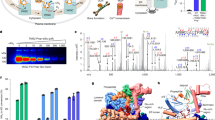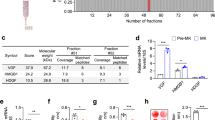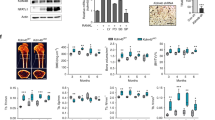Abstract
The γ-carboxylation state of osteocalcin determines its essential functions in bone mineralization or systemic metabolism and serves as a prominent biomarker for bone health and vitamin K nutrition. This post-translational modification of glutamate residues is catalyzed by the membrane-embedded vitamin K-dependent γ-carboxylase (VKGC), which typically recognizes protein substrates through their tightly bound propeptide that triggers γ-carboxylation. However, the osteocalcin propeptide exhibits negligible affinity for VKGC. To understand the underlying molecular mechanism, we determined the cryo-electron microscopy structures of VKGC with osteocalcin carrying a native propeptide or a high-affinity variant at different carboxylation states. The structures reveal a large chamber in VKGC that maintains uncarboxylated and partially carboxylated osteocalcin in partially unfolded conformations, allowing their glutamate-rich region and C-terminal helices to engage with VKGC at multiple sites. Binding of this mature region together with the low-affinity propeptide effectively stimulates VKGC activity, similar to high-affinity propeptides that differ only in closely fitting interactions. However, the low-affinity propeptide renders osteocalcin prone to undercarboxylation at low vitamin K levels, thereby serving as a discernible biomarker. Overall, our studies reveal the unique interaction of osteocalcin with VKGC and provide a framework for designing therapeutic strategies targeting osteocalcin-related bone and metabolic disorders.
This is a preview of subscription content, access via your institution
Access options
Subscribe to this journal
Receive 12 digital issues and online access to articles
$119.00 per year
only $9.92 per issue
Buy this article
- Purchase on SpringerLink
- Instant access to full article PDF
Prices may be subject to local taxes which are calculated during checkout






Similar content being viewed by others
Data availability
Structure coordinates and cryo-EM maps have been deposited in the Protein Data Bank and the Electron Microscopy Data Bank under accession numbers 9MQE and EMD-48522 for VKGC–OCN (native propeptide) with KH2, 9MQC and EMD-48520 for VKGC–OCN (high-affinity propeptide) with KH2, 9MQB and EMD-48519 for partially carboxylated VKGC–OCN (high-affinity propeptide) with KH2. The MS data have been deposited in ProteomeXchange with the accession number PXD059315.
References
Poser, J. W., Esch, F. S., Ling, N. C. & Price, P. A. Isolation and sequence of the vitamin K-dependent protein from human bone. Undercarboxylation of the first glutamic acid residue. J. Biol. Chem. 255, 8685–8691 (1980).
Al-Qtaitat, A. I. & Aldalaen, S. M. A review of non-collagenous proteins; their role in bone. Am. J. Life Sci. 2, 351–355 (2014).
Booth, S. L., Centi, A., Smith, S. R. & Gundberg, C. The role of osteocalcin in human glucose metabolism: marker or mediator?. Nat. Rev. Endocrinol. 9, 43–55 (2013).
Zoch, M. L., Clemens, T. L. & Riddle, R. C. New insights into the biology of osteocalcin. Bone 82, 42–49 (2016).
Liska, D. J. & Suttie, J. W. Location of gamma-carboxyglutamyl residues in partially carboxylated prothrombin preparations. Biochemistry 27, 8636–8641 (1988).
Hoang, Q. Q., Sicheri, F., Howard, A. J. & Yang, D. S. Bone recognition mechanism of porcine osteocalcin from crystal structure. Nature 425, 977–980 (2003).
Price, P. A., Otsuka, A. A., Poser, J. W., Kristaponis, J. & Raman, N. Characterization of a gamma-carboxyglutamic acid-containing protein from bone. Proc. Natl. Acad. Sci. USA 73, 1447–1451 (1976).
Boskey, A. L. et al. Fourier transform infrared microspectroscopic analysis of bones of osteocalcin-deficient mice provides insight into the function of osteocalcin. Bone 23, 187–196 (1998).
Ducy, P. et al. Increased bone formation in osteocalcin-deficient mice. Nature 382, 448–452 (1996).
Poundarik, A. A. et al. Dilatational band formation in bone. Proc. Natl. Acad. Sci. USA 109, 19178–19183 (2012).
Nikel, O., Laurencin, D., McCallum, S. A., Gundberg, C. M. & Vashishth, D. NMR investigation of the role of osteocalcin and osteopontin at the organic-inorganic interface in bone. Langmuir 29, 13873–13882 (2013).
Hauschka, P. V., Lian, J. B., Cole, D. E. & Gundberg, C. M. Osteocalcin and matrix Gla protein: vitamin K-dependent proteins in bone. Physiol. Rev. 69, 990–1047 (1989).
Lee, N. K. et al. Endocrine regulation of energy metabolism by the skeleton. Cell 130, 456–469 (2007).
Fulzele, K. et al. Insulin receptor signaling in osteoblasts regulates postnatal bone acquisition and body composition. Cell 142, 309–319 (2010).
Oury, F. et al. Endocrine regulation of male fertility by the skeleton. Cell 144, 796–809 (2011).
Oury, F. et al. Osteocalcin regulates murine and human fertility through a pancreas-bone-testis axis. J. Clin. Invest. 123, 2421–2433 (2013).
Patterson-Buckendahl, P. et al. Decreased sensory responses in osteocalcin null mutant mice imply neuropeptide function. Cell Mol. Neurobiol. 32, 879–889 (2012).
Oury, F. et al. Maternal and offspring pools of osteocalcin influence brain development and functions. Cell 155, 228–241 (2013).
Brown, J. P. et al. Serum bone Gla-protein: a specific marker for bone formation in postmenopausal osteoporosis. Lancet 1, 1091–1093 (1984).
Booth, S. L. Roles for vitamin K beyond coagulation. Annu. Rev. Nutr. 29, 89–110 (2009).
Binkley, N. C., Krueger, D. C., Engelke, J. A., Foley, A. L. & Suttie, J. W. Vitamin K supplementation reduces serum concentrations of under-gamma-carboxylated osteocalcin in healthy young and elderly adults. Am. J. Clin. Nutr. 72, 1523–1528 (2000).
Hao, Z., Jin, D. Y., Stafford, D. W. & Tie, J. K. Vitamin K-dependent carboxylation of coagulation factors: insights from a cell-based functional study. Haematologica 105, 2164–2173 (2020).
Murshed, M., Schinke, T., McKee, M. D. & Karsenty, G. Extracellular matrix mineralization is regulated locally; different roles of two gla-containing proteins. J. Cell Biol. 165, 625–630 (2004).
Mosnier, L. O., Zlokovic, B. V. & Griffin, J. H. The cytoprotective protein C pathway. Blood 109, 3161–3172 (2007).
Dahlback, B. Vitamin K-dependent protein S: beyond the protein C pathway. Semin. Thromb. Hemost. 44, 176–184 (2018).
Furie, B. & Furie, B. C. Molecular basis of vitamin K-dependent gamma-carboxylation. Blood 75, 1753–1762 (1990).
Sugiura, I., Furie, B., Walsh, C. T. & Furie, B. C. Propeptide and glutamate-containing substrates bound to the vitamin K-dependent carboxylase convert its vitamin K epoxidase function from an inactive to an active state. Proc. Natl. Acad. Sci. USA 94, 9069–9074 (1997).
Suttie, J. W. et al. Vitamin K-dependent carboxylase: possible role of the substrate “propeptide” as an intracellular recognition site. Proc. Natl. Acad. Sci. USA 84, 634–637 (1987).
Stanley, T. B., Jin, D.-Y., Lin, P.-J. & Stafford, D. W. The propeptides of the vitamin K-dependent proteins possess different affinities for the vitamin K-dependent carboxylase. J. Biol. Chem. 274, 16940–16944 (1999).
Houben, R. J. et al. Characteristics and composition of the vitamin K-dependent gamma-glutamyl carboxylase-binding domain on osteocalcin. Biochem. J. 364, 323–328 (2002).
Houben, R. J. et al. Osteocalcin binds tightly to the gamma-glutamylcarboxylase at a site distinct from that of the other known vitamin K-dependent proteins. Biochem. J. 341, 265–269 (1999).
Morris, D. P., Stevens, R. D., Wright, D. J. & Stafford, D. W. Processive post-translational modification. Vitamin K-dependent carboxylation of a peptide substrate. J. Biol. Chem. 270, 30491–30498 (1995).
Stenina, O., Pudota, B. N., McNally, B. A., Hommema, E. L. & Berkner, K. L. Tethered processivity of the vitamin K-dependent carboxylase: factor IX is efficiently modified in a mechanism which distinguishes Gla’s from Glu’s and which accounts for comprehensive carboxylation in vivo. Biochemistry 40, 10301–10309 (2001).
Suttie, J. W. Vitamin K-dependent carboxylase. Annu. Rev. Biochem. 54, 459–477 (1985).
Berkner, K. L. Vitamin K-dependent carboxylation. Vitam. Horm. 78, 131–156 (2008).
Rost, S. et al. Compound heterozygous mutations in the γ-glutamyl carboxylase gene cause combined deficiency of all vitamin K-dependent blood coagulation factors. Br. J. Haematol. 126, 546–549 (2004).
De Vilder, E. Y., Debacker, J. & Vanakker, O. M. GGCX-associated phenotypes: An overview in search of genotype-phenotype correlations. Int. J. Mol. Sci. 18, 240 (2017).
Cao, Q. et al. Molecular basis of vitamin-K-driven gamma-carboxylation at the membrane interface. Nature 639, 816–824 (2025).
Jorgensen, M. J. et al. Recognition site directing vitamin K-dependent gamma-carboxylation resides on the propeptide of factor IX. Cell 48, 185–191 (1987).
Pan, L. C. & Price, P. A. The propeptide of rat bone gamma-carboxyglutamic acid protein shares homology with other vitamin K-dependent protein precursors. Proc. Natl. Acad. Sci. USA 82, 6109–6113 (1985).
Stanley, T. B., Humphries, J., High, K. A. & Stafford, D. W. Amino acids responsible for reduced affinities of vitamin K-dependent propeptides for the carboxylase. Biochemistry 38, 15681–15687 (1999).
Mutucumarana, V. P., Acher, F., Straight, D. L., Jin, D.-Y. & Stafford, D. W. A conserved region of human vitamin K-dependent carboxylase between residues 393 and 404 is important for its interaction with the glutamate substrate. J. Biol. Chem. 278, 46488–46493 (2003).
Rishavy, M. A. & Berkner, K. L. Insight into the coupling mechanism of the vitamin K-dependent carboxylase: mutation of histidine 160 disrupts glutamic acid carbanion formation and efficient coupling of vitamin K epoxidation to glutamic acid carboxylation. Biochemistry 47, 9836–9846 (2008).
Hao, Z. et al. gamma-Glutamyl carboxylase mutations differentially affect the biological function of vitamin K-dependent proteins. Blood 137, 533–543 (2021).
Zacchi, L. F. et al. Coagulation factor IX analysis in bioreactor cell culture supernatant predicts quality of the purified product. Commun. Biol. 4, 390 (2021).
Kaufman, R. J., Wasley, L. C., Furie, B. C., Furie, B. & Shoemaker, C. B. Expression, purification, and characterization of recombinant gamma-carboxylated factor IX synthesized in Chinese hamster ovary cells. J. Biol. Chem. 261, 9622–9628 (1986).
Cairns, J. R. & Price, P. A. Direct demonstration that the vitamin K-dependent bone Gla protein is incompletely gamma-carboxylated in humans. J. Bone Miner. Res. 9, 1989–1997 (1994).
Malashkevich, V. N., Almo, S. C. & Dowd, T. L. X-ray crystal structure of bovine 3 Glu-osteocalcin. Biochemistry 52, 8387–8392 (2013).
Huang, M., Furie, B. C. & Furie, B. Crystal structure of the calcium-stabilized human factor IX Gla domain bound to a conformation-specific anti-factor IX antibody. J. Biol. Chem. 279, 14338–14346 (2004).
Lin, P. J., Straight, D. L. & Stafford, D. W. Binding of the factor IX gamma-carboxyglutamic acid domain to the vitamin K-dependent gamma-glutamyl carboxylase active site induces an allosteric effect that may ensure processive carboxylation and regulate the release of carboxylated product. J. Biol. Chem. 279, 6560–6566 (2004).
Sekhri, A. et al. The conundrum of “warfarin hypersensitivity”: prolonged partial thromboplastin time from factor IX propeptide mutation. Am. J. Ther. 23, e911–e915 (2016).
Chu, K., Wu, S. M., Stanley, T., Stafford, D. W. & High, K. A. A mutation in the propeptide of Factor IX leads to warfarin sensitivity by a novel mechanism. J. Clin. Invest. 98, 1619–1625 (1996).
Chu, R. et al. Redesign of a four-helix bundle protein by phage display coupled with proteolysis and structural characterization by NMR and X-ray crystallography. J. Mol. Biol. 323, 253–262 (2002).
Li, C. et al. FastCloning: a highly simplified, purification-free, sequence- and ligation-independent PCR cloning method. BMC Biotechnol. 11, 92 (2011).
Goehring, A. et al. Screening and large-scale expression of membrane proteins in mammalian cells for structural studies. Nat. Protoc. 9, 2574–2585 (2014).
Punjani, A., Rubinstein, J. L., Fleet, D. J. & Brubaker, M. A. cryoSPARC: algorithms for rapid unsupervised cryo-EM structure determination. Nat. Methods 14, 290–296 (2017).
Rubinstein, J. L. & Brubaker, M. A. Alignment of cryo-EM movies of individual particles by optimization of image translations. J. Struct. Biol. 192, 188–195 (2015).
Rohou, A. & Grigorieff, N. CTFFIND4: Fast and accurate defocus estimation from electron micrographs. J. Struct. Biol. 192, 216–221 (2015).
Afonine, P. V. et al. Towards automated crystallographic structure refinement with phenix.refine. Acta Crystallogr. D Biol. Crystallogr. 68, 352–367 (2012).
Emsley, P., Lohkamp, B., Scott, W. G. & Cowtan, K. D. Features and development of Coot. Acta Crystallogr. D Biol. Crystallogr. 66, 486–501 (2010).
Jumper, J. et al. Highly accurate protein structure prediction with AlphaFold. Nature 596, 583–589 (2021).
Pettersen, E. F. et al. UCSF ChimeraX: Structure visualization for researchers, educators, and developers. Protein Sci. 30, 70–82 (2021).
Wisniewski, J. R., Zougman, A., Nagaraj, N. & Mann, M. Universal sample preparation method for proteome analysis. Nat. Methods 6, 359–362 (2009).
Ren, F. et al. X-ray structures of the high-affinity copper transporter Ctr1. Nat. Commun. 10, 1386 (2019).
Presnell, S. R., Tripathy, A., Lentz, B. R., Jin, D. Y. & Stafford, D. W. A novel fluorescence assay to study propeptide interaction with gamma-glutamyl carboxylase. Biochemistry 40, 11723–11733 (2001).
Lomize, A. L., Todd, S. C. & Pogozheva, I. D. Spatial arrangement of proteins in planar and curved membranes by PPM 3.0. Protein Sci. 31, 209–220 (2022).
Jo, S., Kim, T., Iyer, V. G. & Im, W. CHARMM-GUI: a web-based graphical user interface for CHARMM. J. Comput. Chem. 29, 1859–1865 (2008).
Higgins-Gruber, S. L. et al. Effect of vitamin K-dependent protein precursor propeptide, vitamin K hydroquinone and glutamate substrate binding on the γ-glutamyl carboxylase’s structure and function. J. Biol. Chem. 285, 31502–31508 (2010).
Acknowledgements
We thank Reza Dastvan and Andrzej Krezel for providing access to HPLC systems. W.L. is supported by National Heart, Lung, and Blood Institute (R01 HL121718), the Vagelos Endowed Chair, the Established Investigator Award and Collaborative Sciences Award from American Heart Association, National Institute of General Medical Sciences (R01 GM131008), Children’s Discovery Institute (MCII 2020-854), National Institute of Allergy and Infectious Diseases (R01 AI158500), and the Forefront of Science Award from W. M. Keck Foundation. B.A.G. is supported by National Institute of Neurological Disorders and Stroke (R01 NS111997), the Eunice Kennedy Shriver National Institute of Child Health & Human Development (R01 HD106051), and National Science Foundation (CHE 2127882). Z.L. is supported by a BMB Research Seed Grant (PJ000027587) and National Institute on Aging (P30 AG066444). B.L. is supported by the Hormel Institute, University of Minnesota.
Author information
Authors and Affiliations
Contributions
Q.C. carried out the cryo-EM, functional, and MS experiments. J.F. analyzed OCN and VKGC mutants with assistance from S.A. and S.M. A.A. and Z.L. performed the MS analyses with B.A.G.’s support. H.C. and J.X. assisted with the in vitro γ-carboxylation assay. B.L. determined the structures. W.L. conceived and directed the project, and wrote the manuscript with input from Q.C. and other authors.
Corresponding authors
Ethics declarations
Competing interests
The authors declare no competing interests.
Additional information
Publisher’s note Springer Nature remains neutral with regard to jurisdictional claims in published maps and institutional affiliations.
Rights and permissions
Springer Nature or its licensor (e.g. a society or other partner) holds exclusive rights to this article under a publishing agreement with the author(s) or other rightsholder(s); author self-archiving of the accepted manuscript version of this article is solely governed by the terms of such publishing agreement and applicable law.
About this article
Cite this article
Cao, Q., Fan, J., Ammerman, A. et al. Structural insights into the vitamin K-dependent γ-carboxylation of osteocalcin. Cell Res 35, 735–749 (2025). https://doi.org/10.1038/s41422-025-01161-0
Received:
Accepted:
Published:
Issue date:
DOI: https://doi.org/10.1038/s41422-025-01161-0
This article is cited by
-
Osteocalcin has many tricks to get γ-carboxylated
Cell Research (2025)



